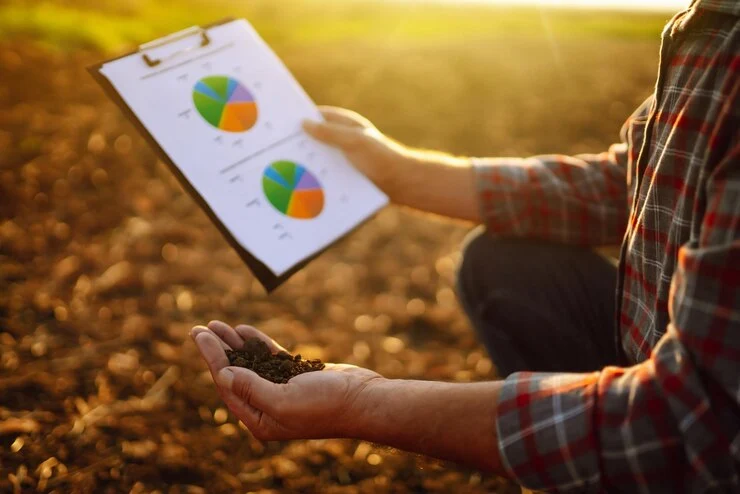In an era where technology is revolutionizing industries across the globe, agriculture is not left behind. Agrosahas International Private Limited is at the forefront of this transformation, harnessing the power of data and digital tools to improve farming practices and outcomes. Through the strategic use of data analytics, we are driving a new wave of efficiency, sustainability, and profitability in agriculture. But how exactly are data and digital tools transforming agriculture, and why is this important?
The Role of Data Analytics in Agriculture
Data analytics in agriculture involves the systematic analysis of various data points to extract meaningful insights. These insights help farmers make informed decisions about their practices. Here are a few ways data analytics is being used in agriculture:
1. Precision Farming:
Precision farming uses data analytics to optimize field-level management regarding crop farming. By analyzing data from various sources such as soil sensors, weather forecasts, and satellite imagery, farmers can determine the exact amount of water, fertilizer, and pesticides needed for specific areas of their fields. This targeted approach reduces waste, lowers costs, and increases crop yields.
2. Predictive Analytics:
Predictive analytics uses historical data to forecast future events. In agriculture, this can mean predicting crop yields, pest infestations, or the best planting and harvesting times. By anticipating these factors, farmers can take proactive measures to mitigate risks and maximize productivity.
3. Resource Management:
Effective resource management is crucial in farming. Data analytics helps farmers monitor and manage resources such as water, energy, and labor more efficiently. For example, smart irrigation systems use real-time data to optimize water usage, ensuring crops receive the right amount of water without wastage.

The Importance of Data Collection in Agriculture
Collecting data is the foundation upon which data analytics builds. In agriculture, data collection is essential for several reasons:
1. Informed Decision-Making:
Data collection provides the raw information needed for analysis. Without accurate and comprehensive data, farmers cannot make informed decisions about their practices. This includes everything from planting schedules to pest control measures.
2. Monitoring and Evaluation:
Continuous data collection allows farmers to monitor the health of their crops and the effectiveness of their practices. This ongoing evaluation helps in identifying problems early and making necessary adjustments to improve outcomes.
3. Traceability and Transparency:
In today’s market, consumers are increasingly concerned about the origins of their food. Data collection ensures traceability, allowing farmers to provide transparency about their practices. This builds consumer trust and can lead to higher market value for their products.
Understanding Big Data Analytics in Agriculture
Big data analytics in agriculture refers to the use of large and complex data sets to gain insights that were previously unattainable. Big data comes from multiple sources, including satellite imagery, climate data, social media, and more. Here’s how big data analytics is transforming agriculture:
1. Enhanced Decision Support:
Big data analytics integrates various data sources to provide a holistic view of agricultural practices. This comprehensive perspective helps farmers make better decisions by understanding the interdependencies of different factors.
2. Risk Management:
Agriculture is inherently risky due to factors like weather and market volatility. Big data analytics helps mitigate these risks by providing accurate forecasts and trend analyses. Farmers can prepare for adverse conditions and take steps to protect their investments.
3. Innovative Solutions:
By analyzing big data, researchers and agribusinesses can develop innovative solutions to agricultural challenges. This includes creating new crop varieties, improving pest control methods, and enhancing soil management practices.

Key Data Points for Farmers
Not all data is created equal, and certain types of data are particularly important for farmers. These include:
1. Weather Data:
Weather conditions significantly impact farming activities. Accurate weather data helps farmers plan their planting, irrigation, and harvesting schedules. It also aids in preparing for extreme weather events that could damage crops.
2. Soil Data:
Understanding soil composition and health is crucial for crop growth. Soil data, including pH levels, nutrient content, and moisture levels, helps farmers optimize their soil management practices.
3. Crop Data:
Detailed information about crop growth stages, health, and yield predictions allows farmers to make timely interventions. This data includes information on plant diseases, pest infestations, and growth patterns.
4. Market Data:
Market trends and pricing information help farmers make strategic decisions about what to grow and when to sell their produce. Access to this data can improve profitability and reduce financial risk.
Conclusion
At Agrosahas International Private Limited, we believe that data-driven agriculture is the key to a sustainable and prosperous future. By leveraging data analytics and digital tools, we are transforming traditional farming practices into efficient, resilient, and profitable operations. Data collection, analysis, and the application of big data analytics are integral to this transformation, providing farmers with the insights they need to thrive in an increasingly complex agricultural landscape.
As we continue to innovate and embrace new technologies, we remain committed to empowering farmers with the tools and knowledge they need to succeed. Through our digital agriculture initiatives, we are not just improving farming outcomes; we are shaping the future of agriculture for generations to come.




